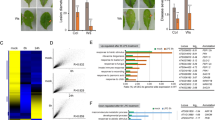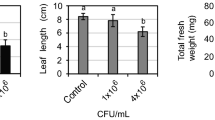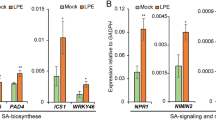Abstract
Main conclusion
The phytotoxin botrydial triggers PA production in tomato cell suspensions via PLD and PLC/DGK activation. PLC/DGK-derived PA is partially required for botrydial-induced ROS generation.
Phosphatidic acid (PA) is a phospholipid second messenger involved in the induction of plant defense responses. It is generated via two distinct enzymatic pathways, either via phospholipase D (PLD) or by the sequential action of phospholipase C and diacylglycerol kinase (PLC/DGK). Botrydial is a phytotoxic sesquiterpene generated by the necrotrophic fungus Botrytis cinerea that induces diverse plant defense responses, such as the production of reactive oxygen species (ROS). Here, we analyzed PA and ROS production and their interplay upon botrydial treatments, employing tomato (Solanum lycopersicum) cell suspensions as a model system. Botrydial induces PA production within minutes via PLD and PLC/DGK. Either inhibition of PLC or DGK diminishes ROS generation triggered by botrydial. This indicates that PLC/DGK is upstream of ROS production. In tomato, PLC is encoded by a multigene family constituted by SlPLC1–SlPLC6 and the pseudogene SlPLC7. We have shown that SlPLC2-silenced plants have reduced susceptibility to B. cinerea. In this work, we studied the role of SlPLC2 on botrydial-induced PA production by silencing the expression of SlPLC2 via a specific artificial microRNA. Upon botrydial treatments, SlPLC2-silenced-cell suspensions produce PA levels similar to wild-type cells. It can be concluded that PA is a novel component of the plant responses triggered by botrydial.





Similar content being viewed by others
Abbreviations
- DGK:
-
Diacylglycerol kinase
- DPI:
-
Diphenyleneiodonium chloride
- EtAc:
-
Ethyl acetate
- MAMP:
-
Microbe-associated molecular patterns
- PA:
-
Phosphatidic acid
- PIP:
-
Phosphatidylinositol 4-phosphosphate
- PIP2 :
-
Phosphatidylinositol 45-bisphosphate
- PLC:
-
Phospholipase C
- PLD:
-
Phopholipase D
References
Abd-El-Haliem AM, Vossen JH, van Zeijl A, Dezhsetan S, Testerink C, Seidl MF, Beck M, Strutt J, Robatzek S, Joosten MH (2016) Biochemical characterization of the tomato phosphatidylinositol-specific phospholipase C (PI-PLC) family and its role in plant immunity. Biochim Biophys Acta 1861:1365–1378
Andersson MX, Kourtchenko O, Dangl JL, Mackey D, Ellerstrom M (2006) Phospholipase-dependent signalling during the AvrRpm1- and AvrRpt2-induced disease resistance responses in Arabidopsis thaliana. Plant J 47:947–959
Bargmann BO, Laxalt AM, Riet BT, Schouten E, van Leeuwen W, Dekker HL, de Koster CG, Haring MA, Munnik T (2006) LePLDbeta1 activation and relocalization in suspension-cultured tomato cells treated with xylanase. Plant J 45:358–368
Bargmann BO, Laxalt AM, ter Riet B, Testerink C, Merquiol E, Mosblech A, Leon-Reyes A, Pieterse CM, Haring MA, Heilmann I, Bartels D, Munnik T (2009) Reassessing the role of phospholipase D in the Arabidopsis wounding response. Plant Cell Environ 32:837–850
Boller T, Felix G (2009) A renaissance of elicitors: perception of microbe-associated molecular patterns and danger signals by pattern-recognition receptors. Annu Rev Plant Biol 60:379–406
Cacas JL, Gerbeau-Pissot P, Fromentin J, Cantrel C, Thomas D, Jeannette E, Kalachova T, Mongrand S, Simon-Plas F, Ruelland E (2017) Diacylglycerol kinases activate tobacco NADPH oxidase-dependent oxidative burst in response to cryptogein. Plant Cell Environ 40:585–598
Chisholm ST, Coaker G, Day B, Staskawicz BJ (2006) Host-microbe interactions: shaping the evolution of the plant immune responses. Cell 124:803–814
Collado IG, Viaud M (2016) Secondary metabolism in Botrytis cinerea: combining genomic and metabolomic approaches. In: Fillinger S, Elad Y (eds) Botrytis—the fungus, the pathogen and its management in agricultural systems. Springer, Cham, pp 291–313
Colmenares AJ, Aleu J, Duran-Patron R, Collado IG, Hernandez-Galan R (2002) The putative role of botrydial and related metabolites in the infection mechanism of Botrytis cinerea. J Chem Ecol 28:997–1005
D’Ambrosio JM, Couto D, Fabro G, Scuffi D, Lamattina L, Munnik T, Andersson MX, Alvarez ME, Zipfel C, Laxalt AM (2017) PLC2 regulates MAMP-triggered immunity by modulating ROS production in Arabidopsis. Plant Physiol 175(2):970–981
de Jong CF, Laxalt AM, Bargmann BO, de Wit PJGM, Joosten MHAJ, Munnik T (2004) Phosphatidic acid accumulation is an early response in the Cf-4/Avr4 interaction. Plant J 39:1–12
Dean R, Van Kan JAL, Pretorius ZA, Hammond-Kosack KE, Di Piertro A, Spanu PD, Rudd JJ, Dickman M, Kahmann R, Ellis J, Foster GD (2012) The top 10 fungal pathogens in molecular plant pathology. Mol Plant Pathol 13:414–430
Deighton N, Muckenschnabel I, Colmenares AJ, Collado IG, Williamson B (2001) Botrydial is produced in plant tissues infected by Botrytis cinerea. Phytochemistry 57:689–692
den Hartog M, Verhoef N, Munnik T (2003) Nod factor and elicitors activate different phospholipid signaling pathways in suspension-cultured alfalfa cells. Plant Physiol 132:311–317
Glazebrook J (2005) Contrasting mechanisms of defense against biotrophic and necrotrophic pathogens. Annu Rev Phytopathol 43:205–227
Gonorazky G, Laxalt AM, de la Canal L (2010) Involvement of phospholipase C in the responses triggered by extracellular phosphatidylinositol 4-phosphate. J Plant Physiol 167:411–415
Gonorazky G, Ramirez L, Abd-El-Haliem A, Vossen JH, Lamattina L, ten Have A, Joosten MH, Laxalt AM (2014) The tomato phosphatidylinositol-phospholipase C2 (SlPLC2) is required for defense gene induction by the fungal elicitor xylanase. J Plant Physiol 171:959–965
Gonorazky G, Guzzo MC, Abd-El-Haliem AM, Joosten MH, Laxalt AM (2016) Silencing of the tomato phosphatidylinositol-phospholipase C2 (SlPLC2) reduces plant susceptibility to Botrytis cinerea. Mol Plant Pathol 17:1354–1363
Govrin EM, Levine A (2000) The hypersensitive response facilitates plant infection by the necrotrophic pathogen Botrytis cinerea. Curr Biol 10:751–757
Laxalt AM, Raho N, ten Have A, Lamattina L (2007) Nitric oxide is critical for inducing phosphatidic acid accumulation in xylanase-elicited tomato cells. J Biol Chem 282:21160–21168
Mengiste T (2012) Plant immunity to necrotrophs. Annu Rev Phytopathol 50:267–294
Mueller-Roeber B, Pical C (2002) Inositol phospholipid metabolism in Arabidopsis. Characterized and putative isoforms of inositol phospholipid kinase and phosphoinositide-specific phospholipase C. Plant Physiol 130:22–46
Munnik T (2001) Phosphatidic acid: an emerging plant lipid second messenger. Trends Plant Sci 6:227–233
Munnik T (2014) PI-PLC: phosphoinositide-phospholipase C in plant signaling. In: Wang X (ed) Phospholipases in plant signaling. Springer, Berlin Heidelberg, pp 27–54
Orozco-Cardenas ML, Narvaez-Vasquez J, Ryan CA (2001) Hydrogen peroxide acts as a second messenger for the induction of defense genes in tomato plants in response to wounding, systemin, and methyl jasmonate. Plant Cell 13:179–191
Ossowski S, Schwab R, Weigel D (2008) Gene silencing in plants using artificial microRNAs and other small RNAs. Plant J 53:674–690
Piedras P, Hammond-Kosack KE, Harrison K, Jones JDG (1998) Rapid, Cf-9- and Avr9-dependent production of active oxygen species in tobacco suspension cultures. Mol Plant-Microbe Interact 11:1155–1166
Raho N, Ramirez L, Lanteri ML, Gonorazky G, Lamattina L, ten Have A, Laxalt AM (2011) Phosphatidic acid production in chitosan-elicited tomato cells, via both phospholipase D and phospholipase C/diacylglycerol kinase, requires nitric oxide. J Plant Physiol 168:534–539
Rossi FR, Garriz A, Marina M, Romero FM, Gonzalez ME, Collado IG, Pieckenstain FL (2011) The sesquiterpene botrydial produced by Botrytis cinerea induces the hypersensitive response on plant tissues and its action is modulated by salicylic acid and jasmonic acid signaling. Mol Plant Microbe Interact 24:888–896
Sueldo DJ, Foresi NP, Casalongué CA, Lamattina L, Laxalt AM (2010) Phosphatidic acid formation is required for extracellular ATP-mediated nitric oxide production in suspension-cultured tomato cells. New Phytol 185:909–916
Testerink C, Munnik T (2011) Molecular, cellular, and physiological responses to phosphatidic acid formation in plants. J Exp Bot 62:2349–2361
Thomma BPHJ, Nürnberger T, Joosten MHAJ (2011) Of PAMPs and effectors: the blurred PTI-ETI dichotomy. Plant Cell 23:4–15
van Baarlen P, Woltering EJ, Staats M, van Kan JAL (2007) Histochemical and genetic analysis of host and non-host interactions of Arabidopsis with three Botrytis species: an important role for cell death control. Mol Plant Pathol 8:41–54
van der Luit AH, Piatti T, van Doorn A, Musgrave A, Felix G, Boller T, Munnik T (2000) Elicitation of suspension-cultured tomato cells triggers the formation of phosphatidic acid and diacylglycerol pyrophosphate. Plant Physiol 123:1507–1516
van Kan JA (2006) Licensed to kill: the lifestyle of a necrotrophic plant pathogen. Trends Plant Sci 11:247–253
Vossen JH, Abd-El-Haliem A, Fradin EF, van den Berg GC, Ekengren SK, Meijer HJ, Seifi A, Bai Y, ten Have A, Munnik T, Thomma BP, Joosten MH (2010) Identification of tomato phosphatidylinositol-specific phospholipase-C (PI-PLC) family members and the role of PLC4 and PLC6 in HR and disease resistance. Plant J 62:224–239
Wang X, Guo L, Wang G, Li M (2014a) PLD: phospholipase Ds in plant signaling. In: Wang X (ed) Phospholipases in plant signaling. Springer, Berlin Heidelberg, pp 3–26
Wang X, Jiang N, Liu J, Liu W, Wang GL (2014b) The role of effectors and host immunity in plant–necrotrophic fungal interactions. Virulence 5:722–732
Wrzaczek M, Brosche M, Kangasjarvi J (2013) ROS signaling loops—production, perception, regulation. Curr Opin Plant Biol 16:575–582
Yamaguchi T, Minami E, Shibuya N (2003) Activation of phospholipases by N-acetylchitooligosaccharide elicitor in suspension-cultured rice cells mediates reactive oxygen generation. Physiol Plant 118:361–370
Yamaguchi T, Minami E, Ueki J, Shibuya N (2005) Elicitor-induced activation of phospholipases plays an important role for the induction of defense responses in suspension-cultured rice cells. Plant Cell Physiol 46:579–587
Zhang Y, Zhu H, Zhang Q, Li M, Yan M, Wang R, Wang L, Welti R, Zhang W, Wang X (2009) Phospholipase Dα1 and phosphatidic acid regulate NADPH oxidase activity and production of reactive oxygen species in ABA-mediated stomatal closure in Arabidopsis. Plant Cell 21:2357–2377
Zhao J, Devaiah SP, Wang C, Li M, Welti R, Wang X (2013) Arabidopsis phospholipase D beta1 modulates defense responses to bacterial and fungal pathogens. New Phytol 199:228–240
Funding
This work was financially supported by the Agencia Nacional de Promoción Científica y Tecnológica (ANPCyT), Universidad Nacional de Mar del Plata (UNMdP) and the Consejo Nacional de Investigaciones Científicas y Técnicas (CONICET). J.M.D’Ambrosio is a postdoctoral researcher of the research career of CONICET. G. Gonorazky, A.M. Laxalt, and L. Lamattina are members of the research career of CONICET.
Author information
Authors and Affiliations
Corresponding author
Electronic supplementary material
Below is the link to the electronic supplementary material.
Rights and permissions
About this article
Cite this article
D’Ambrosio, J.M., Gonorazky, G., Sueldo, D.J. et al. The sesquiterpene botrydial from Botrytis cinerea induces phosphatidic acid production in tomato cell suspensions. Planta 247, 1001–1009 (2018). https://doi.org/10.1007/s00425-018-2843-8
Received:
Accepted:
Published:
Issue Date:
DOI: https://doi.org/10.1007/s00425-018-2843-8




